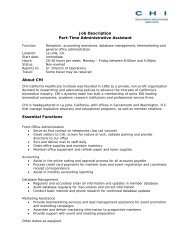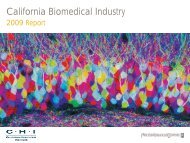California Biomedical Industry - California Healthcare Institute
California Biomedical Industry - California Healthcare Institute
California Biomedical Industry - California Healthcare Institute
You also want an ePaper? Increase the reach of your titles
YUMPU automatically turns print PDFs into web optimized ePapers that Google loves.
University of Southern <strong>California</strong>“The research funded by the NIH atUSC leads to a rich pipeline of emergingtherapies and products,” said KrisztinaHolly, vice provost for innovation andexecutive director of the USC Stevens<strong>Institute</strong> for Innovation. “It forms the basisfor many exciting new companies that webelieve will improve the lives of millions.”She added that historically, 50 percentof USC licensing income comes from lifesciences inventions, while 45 percent oflicensing deals in 2009 were from the lifesciences.Start-ups••Syntouch (www.syntouchllc.com) has developed a novel, robusttactile sensor array that mimicsthe mechanical properties anddistributed touch receptors of thehuman fingertip. Initial applicationsbeing developed include tactilesensors for prosthetic hands. NIHfunding from: National <strong>Institute</strong>of Child Health and HumanDevelopment (NICHD)••Tocagen (www.tocagen.com)is a biopharmaceutical companypursuing the discovery, developmentand commercialization of productsfor the treatment of cancer. Theinitial focus is on treatments forpatients with very advanced cancerfor whom no adequate treatmentcurrently exists. Tocagen’sControlled Active Gene TransferTechnology (CAGT) platform is aunique viral based technology that isdesigned to carry a therapeutic geneand selectively kill cancer cells whilenot harming healthy tissue. Tocagenhas recently commenced a Phase Ihuman clinical trial evaluating thecompany’s first candidate in thesetting of Glioblastoma Multiforme,the most common aggresive primarybrain cancer. NIH funding from:National Cancer <strong>Institute</strong> (NCI) andNational <strong>Institute</strong> of NeurologicalDisorders and Stroke (NINDS)••Anergix, LLC (www.anergix4ms.com) is developing a therapythat triggers the body’s naturalmechanisms to turn offmalfunctioning immune cells,effectively addressing a widerange of autoimmune diseasesincluding multiple sclerosis. InMS, malfunctioning immunecells (T-lymphocytes) attack anddamage the myelin sheaths coveringnerves in the brain. USC scientistsdiscovered that presenting immuneregulatory cells in the body withfragments of myelin activated themto turn off the malfunctioningT-lymphocytes in the brain. Todeliver these myelin fragments,or peptides, Anergix sequestersproprietary peptide-secreting cellsin a small device implanted underthe skin. Thus continuous, low dosetherapeutic levels of the peptide aregenerated on a systemic basis. NIHfunding from: National <strong>Institute</strong> ofNeurological Disorders and Stroke(NINDS)Research HighlightsConnecting scientists to spurmedical innovation<strong>Biomedical</strong> Informatics ResearchNetwork (BIRN) CoordinatingCenter funded by NCRR/NIH. CarlKesselman, principle investigator (PI).The coordinating center for BIRNcollects biomedical imaging datafrom institutions all over the country,currently with a heavy emphasis onneuroscience. The BIRN coordinatingcenter has the task of facilitatingcollaboration and data sharing betweenthe research centers. BIRN helpsconnect scientists with their colleaguesnationwide to share data and refineanalytic tools that can be used for multisitedata integration. BIRN partnersare essential to advancing technologiesincluding new software-based solutions,which are crucial to discoveries thathave broad applicability to biomedicalresearch.Innovative cancer modelingPhysical Sciences-Oncology Centerfunded by NCI/NIH. W. Daniel Hillis,PI and David Agus, Senior ScientificInvestigator. This is one of 12 centersfunded nationwide under a programthat promotes greater understandingof cancer through the applicationof methodologies from the physicalsciences. The overall goal of this centeris to thoroughly understand therapeuticresponse in cancer. Investigators willestablish a predictive model of cancerthat they can utilize to determine tumorsteady state growth and drug response,particularly those involved in thehematological malignancies of acutemyeloid leukemia and non-Hodgkin’slymphoma. Furthermore, multi-scalephysical measurements will be unifiedwith sophisticated modeling approachesto facilitate the development of amodel that can derive the tumor’s traitsduring its growth and after any distress,such as chemotherapeutic treatment.Overall, the predictive tumor responsemodel developed in this effort shouldenable clinicians to determine the mostefficacious therapies a priori and reducedeleterious side effects.Moving research from bench tobedsideLos Angeles Basin Clinical andTranslational Science <strong>Institute</strong>. Thomas74 | <strong>California</strong> <strong>Biomedical</strong> <strong>Industry</strong> 2011 Report






